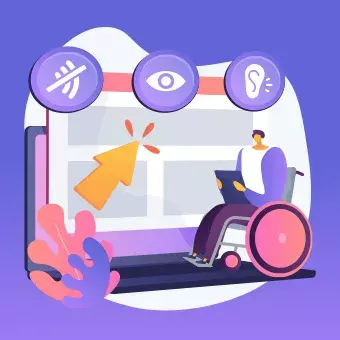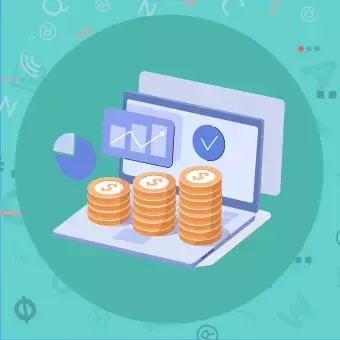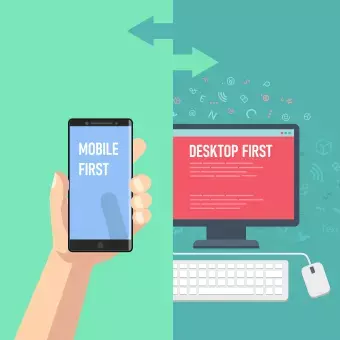Introduction
Web accessibility is an aspect of web development that is often under-represented. In this article, we will aim to provide a foundational understanding of this important subject, by exploring the fundamentals of web accessibility and discussing its core principles and relevant features.
What is Web Accessibility?
Web accessibility is the practice of ensuring that websites are designed and developed in a manner that makes them accessible to all users, irrespective of any physical or cognitive impairments. In simpler terms, it’s about removing barriers that could prevent interaction with, or access to, websites by individuals with disabilities.
Accessibility goes beyond just catering to users with apparent disabilities like visual or auditory impairments; it also considers those with temporary disabilities like a broken arm, or situational limitations such as bright sunlight affecting screen visibility.
Looking for a Web Agency?
The Four Principles of Accessibility (POUR)
There are four foundational principles of accessibility. These principles are often abbreviated as POUR, which stands for Perceivable, Operable, Understandable, and Robust. These principles serve as a framework for both understanding and implementing effective web accessibility.
Here’s a quick breakdown of those four principles:
Perceivable
Information and user interface components need to be presented in a way that users can perceive. This means that information shouldn’t rely solely on one sensory characteristic like sound or sight.
Examples:
- Providing alternative text for images.
- Using readable fonts and contrast ratios for text.
- Providing captions and transcripts for audio and video content.
Operable
The interface and structure should be operable for the user. Users must be able to interact with the UI and navigate it successfully
Examples:
- Keyboard-navigable menus and links.
- Adjustable time limits for tasks.
- Skip links to bypass repetitive content.
Understandable
Both the information presented and the user interface must be understandable. This involves making text readable and predictable and offering straightforward ways to correct mistakes.
Examples:
- Consistent navigation menus.
- Clear and concise error messages.
- Form labels and instructions.
Robust
Content must be robust enough to be interpreted reliably by a wide variety of user agents, including assistive technologies. In other words, your website should work well with screen readers and other accessibility tools.
Examples:
- Code validation to ensure it meets established standards.
- Compatibility with screen readers.
- Progressive enhancement techniques for different devices and browsers.
The POUR principles offer a framework that can guide developers in creating websites and apps that are not just accessible, but also functional and user-friendly for everyone.
Why Accessibility Matters to Developers
While web accessibility is often discussed in the context of its social and ethical implications, it also has significant relevance for developers. As an agency that offers web services, we believe that understanding and integrating accessibility into your development process is an essential component of quality web development.
Here’s why it matters:
Technical Excellence
Implementing accessibility features often aligns with best practices in web development, such as semantic HTML markup, which benefits both the user and the developer.
Broader Reach
An accessible website is a more inclusive one, meaning it has the potential to reach a wider audience. This is not just good ethics; it’s also good engineering.
Future-Proofing
As web standards evolve, accessibility is becoming more ingrained in the development process. Building accessible websites now can save you from costly overhauls in the future.
Legal Considerations
In certain geographies and sectors there are laws and regulations that require websites to be accessible, making this a compliance issue in these cases as well as a technical one.
Common Accessibility Features
Implementing accessibility might seem like a daunting task at first glance, but there are several straightforward features that can make a significant difference. Here are some to consider:
- Alternative Text for Images: Alt text helps screen readers describe images, offering a textual alternative for visual content.
- Keyboard Navigation: It should be possible to activate and navigate all interactive elements using just a keyboard. This is especially important for users who cannot use a mouse.
- ARIA Roles and Landmarks: Accessible Rich Internet Applications (ARIA) roles and landmarks provide additional information to assistive technologies, helping to make your web content more accessible.
- Readable Fonts and Colour Contrast: Text should be easily readable, with sufficient contrast between text and background colours. Tools like WebAIM’s contrast checker can be helpful.
- Captions and Transcripts: For multimedia content, provide captions for video and transcripts for audio to ensure that users with hearing impairments can access this type of content.
- Resizable Text: Users should be able to resize text without it affecting the website’s functionality or layout.
- Skip Links: These are internal page links that allow users to skip directly to the content, bypassing navigation menus and other repetitive elements.
- Error Identification: Clearly identify errors in form fields and offer guidance on how to correct them.
- Page Titles and Headers: Use descriptive titles and headers to facilitate easier navigation and understanding of the content.
- Accessible Forms: Labels and fieldsets should be used to make forms more accessible, along with error messages and validation feedback.
By incorporating these features into your development process, you are taking significant steps toward making your websites more accessible to a broader range of users.
Accessibility Testing
Testing is a crucial aspect of web development, and it’s no different when it comes to accessibility. Here are some key points and tools to consider:
- Automated Testing Tools: Several automated tools can scan your website for accessibility issues. Examples include WAVE, axe, and Lighthouse. While these tools are great for catching common issues, they’re not a replacement for manual testing.
- Manual Testing: This involves going through the website to ensure that all features are accessible. Manual testing should be done using various assistive technologies like screen readers and keyboard-only navigation.
- User Testing: The best way to understand the accessibility of your website is to have people with disabilities test it. This can provide invaluable insights into the user experience.
- Code Validation: Ensuring that your code meets established web standards is another way to check its accessibility. Validators like the W3C Markup Validation Service can be used for this purpose.
- Monitor Periodically: Accessibility isn’t a one-off task but requires ongoing monitoring and updates. Regularly schedule accessibility checks as part of your maintenance routine.
- Documentation: Keep a record of your testing processes, the tools used, and the issues identified. This can be helpful for both internal reviews and compliance audits.
Effective testing is key to ensuring that your accessibility efforts are successful and that you’re providing an inclusive user experience.
Resources to Learn More
If you’re interested in learning more about web accessibility, there are plenty of resources available. Here are few starting points for further reading:
- W3C Web Accessibility Initiative: The WAI provides guidelines, techniques, and resources that are essential for anyone looking to understand web accessibility comprehensively.
- WebAIM: This organisation offers a variety of tools and articles, including the widely-used WebAIM contrast checker and valuable tutorials.
- A11y Project: A community-driven effort that provides checklists, patterns, and other resources to simplify the accessibility process.
- MDN Web Docs: Mozilla’s documentation includes a thorough section on accessibility that covers topics ranging from HTML to ARIA roles.
Why Accessibility Matters to Us
We couldn’t talk about web accessibility without sharing something from our own journey.
In the early stages of our agency, our manager Dean worked as a developer on a project for a local non-profit catering to individuals with various disabilities. We built a lasting relationship with this client, the project was a defining experience for our team and it changed our perspective on web accessibility.While every business has to consider the Total Cost of Ownership (TCO) when planning their web projects, we believe that the ability to create a web experience that is inclusive, that allows everyone to participate, should be a priority.



